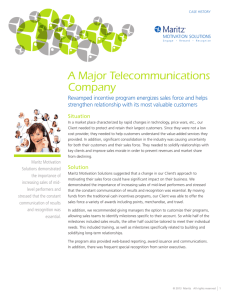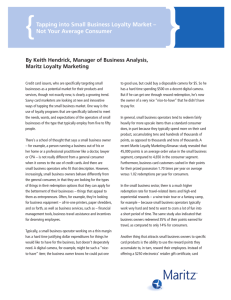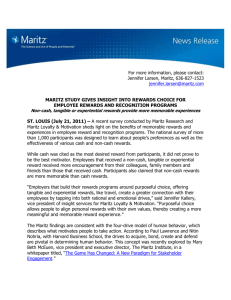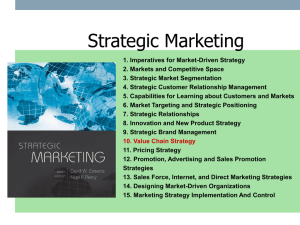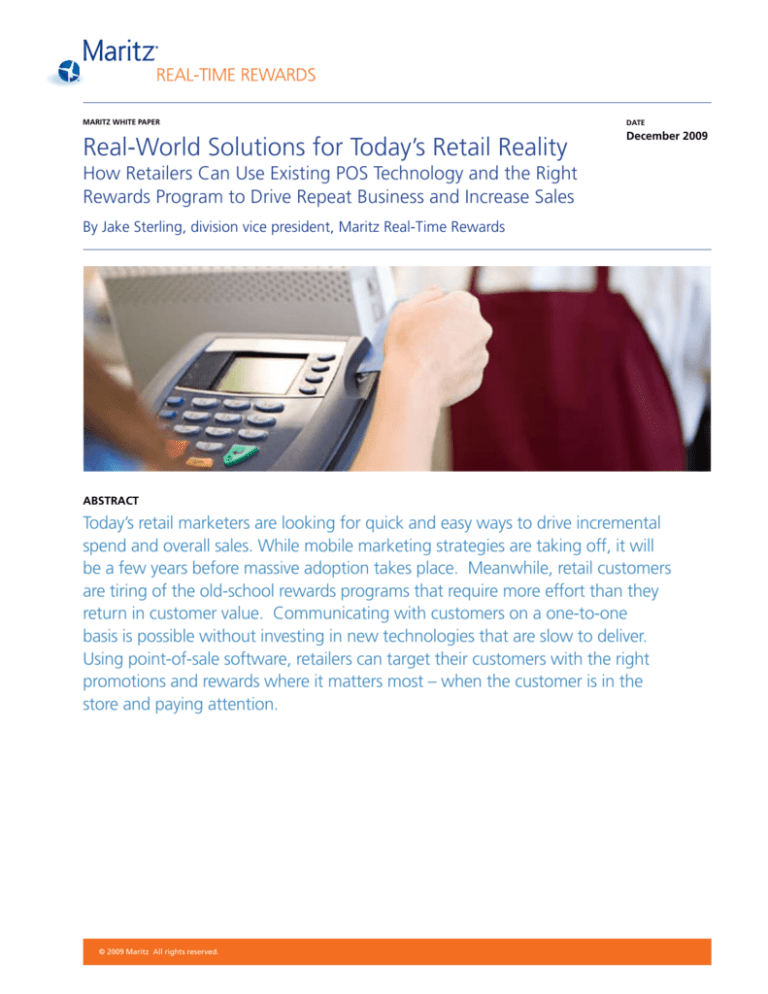
MARITZ WHITE PAPER
DATE
Real-World Solutions for Today’s Retail Reality
December 2009
How Retailers Can Use Existing POS Technology and the Right
Rewards Program to Drive Repeat Business and Increase Sales
By Jake Sterling, division vice president, Maritz Real-Time Rewards
abstract
Today’s retail marketers are looking for quick and easy ways to drive incremental
spend and overall sales. While mobile marketing strategies are taking off, it will
be a few years before massive adoption takes place. Meanwhile, retail customers
are tiring of the old-school rewards programs that require more effort than they
return in customer value. Communicating with customers on a one-to-one
basis is possible without investing in new technologies that are slow to deliver.
Using point-of-sale software, retailers can target their customers with the right
promotions and rewards where it matters most – when the customer is in the
store and paying attention.
© 2009 Maritz All rights reserved.
1
MARITZ WHITE PAPER
DATE
Real-World Solutions for Today’s Retail Reality
December 2009
It seems like everyone in the retail industry is jumping on the
mobile marketing bandwagon. Dairy Queen has announced
an RFID sticker that customers can attach to a phone or wallet
to receive targeted promotional offers in store. Burger King
has introduced an iPhone application that allows users to place
orders automatically. Whole Foods is making more than
2,000 recipes available to its customers via an app for both
iPhone and iPod users. Text messaging, social networking, and
smart phones are opening up new avenues for reaching and
creating loyal customers.
Problem #1: You don’t know me. Most retail rewards
programs ascribe to the generic “do this, get that” formula,
with little to no regard for individual customers and their
unique interactions with the store. All participants receive
the same discount or the same promotion. Not only does this
alienate your best customers, it’s also a waste of marketing
dollars because you’re spending money on people who have
no intention of engaging in the desired behavior, and aren’t
motivated by the reward you’re offering.
While they make for great publicity and show promise for the
future, mobile technology programs aren’t translating into
sustained increases in retail sales. Consider the following:
Keeping track of points, coupons, fobs, multiple cards
or receipts is complicated and messy when the average
household belongs to 14.1 loyalty rewards programs.6
Unfortunately, most retail rewards programs require customers
to bring in a coupon they received in the mail or online to
receive their award or discount. Many programs also have a
lengthy registration process that involves filling out forms and,
in some cases, holding up the checkout line. Forcing your best
customers to jump through hoops to participate in your loyalty
program is frustrating for them and has the opposite effect of
your original intention — to create customer loyalty.
Problem #2 Your program is inconvenient.
• Less than 10 percent of credit cards in the US have
RFID chips in them and retailers have been slow to adopt
the technology1
• 77 percent of the entire mobile market do not own
an iPhone2
• 40 percent of Mobile Users do not use text messaging3
• 51 percent of Americans do NOT participate in social
networking sites such as Facebook or Twitter4
Currently, the retail industry invests four to six percent of
its revenue on marketing support.5 Channeling precious
marketing dollars into programs using these technologies will
put a large number of customers out of reach, no matter the
target market. Clearly, this is a problem, especially if some of
those customers are the best customers.
Retail Rewards Programs –
Do They Deliver?
While retailers keep tabs on the latest mobile technology,
many are banking on the promise of their rewards programs.
Today’s rewards programs have become more sophisticated,
tracking spend and purchases, and capturing other customer
information. But, most fall short in actually using the data to
provide meaningful offers to customers.
© 2009 Maritz All rights reserved.
Problem #3 Can you hear me now? As mentioned,
retailers are becoming savvier with their marketing
programs and are beginning to use advanced technologies
to communicate with their customers. But the reality is,
no matter what vehicle you use to communicate with your
customer – whether a direct mail piece, text message, social
media ad or email – you’re communicating to a customer on
their personal time, not when they’re shopping at your store.
And, because most offers aren’t personalized to the customer’s
unique preferences and needs, most customers (97 to 99
percent) don’t respond.7 That’s why 65 percent of Gen Yers
say they were “unlikely to or would definitely not subscribe”
to retail offers solicited via cell phone or PDA.8 While retailers
may be attempting to stay top-of-mind with their customers,
in most cases, they are just part of the daily onslaught of
marketing noise we all “hear” through various forms of media
every day.
2
MARITZ WHITE PAPER
DATE
Real-World Solutions for Today’s Retail Reality
December 2009
With limited marketing dollars and a desire to see real ROI,
retailers need practical solutions that are simple to implement
and drive significant sales volume. One of those practical
solutions features technology that the majority of retailers
already use to communicate directly with their customers –
their POS terminals.
While most retailers think of the POS terminal as a transaction
tool to exchange goods for money, they are missing a golden
opportunity to speak to their customers when they have their
full attention.
Capturing Customers in Real-Time
Maritz’ approach to helping retailers capture customer
mindshare and drive sales now centers on the point-of-sale
and follows these simple precepts:
1. Communicate with the customer when it makes
sense – in real time at the point-of-sale.
2. Motivate customers to engage in behaviors that
make sense for them
3. Reward customers for those behaviors in ways that
are meaningful to them.
Using a proprietary software technology, Maritz can help
retailers execute on this strategy by engaging their customers
at the right time, with the right rewards. Maritz Real-Time
Rewards’ solution helps retailers create their own customized
data driven promotions for individual customers based on prior
purchase behavior.
Using a retailer’s existing POS terminal technology, combined
with Maritz’ software, a merchant can:
• Deliver promotions instantly at the point-of-sale on the
POS terminal and purchase receipts
• Simultaneously leverage the customer database to provide
additional customer insight and target best customers
with promotions
• Integrate an existing points program or create a new
program that allows customers to redeem their points in
real time at the point of sale (eliminating the need for paper
coupons or gift certificates).
© 2009 Maritz All rights reserved.
The right communications, with the right
customers, at the right time.
How it Works
When customers sign up for a retailer’s rewards program
through Maritz Real-Time Rewards, they merely swipe a credit,
debit or loyalty card and are instantly registered. The program
then begins tracking purchasing behavior in order to deliver
targeted promotions. These behaviors can include spend,
number of visits, and time lapsed since the last visit.
Maritz Real-Time Rewards enables retailers to set up
promotions to drive frequency, increase average ticket, reward
best customers, cross sell, market new products or deliver
targeted messaging. In addition, retailers can drive customers
towards higher margin products and/or reward behavior
with low cost items. This targeted approach ensures the right
customer gets the right offer, receiving exactly WHAT they
want, WHEN they want it.
For example:
Chad is a truck driver who stops at “Burger Land” every week.
When he uses his registered credit card, the printed receipt
offers him a free breakfast sandwich if he comes back in
within five days. He does not need to bring the printed receipt
back. He simply swipes his card to redeem his free sandwich
next time.
Beth stops at “Coffee King” on her way to work every
morning for a large latte, but hasn’t thought to visit in the
afternoon. When she uses her registered card, her receipt tells
her to come back on any weekday between noon and three to
receive $2 off any purchase of $5 or more. When she returns,
she need only swipe her card to receive her $2-off reward.
Liz is a frequent “Books & More” shopper and earns three
points for every dollar spent when she uses her “Bank of the
Nation” credit card. Upon checkout at “Books & More,” she
will be prompted at the POS to use her “Bank of the Nation”
reward points to pay for all or part of her purchase and reduce
her out-of-pocket costs. This instant promotion requires
nothing but the card Liz already uses.
3
MARITZ WHITE PAPER
DATE
Real-World Solutions for Today’s Retail Reality
December 2009
Real-Time Success Stories
The Maritz Real-Time Rewards solution has worked for
retailers all over the world through Maritz’ partner, Welcome
Real Time, and its proprietary software.
Case Study #1
Problem: A fast-food chain in Malaysia experienced slow
traffic and decreasing sales after the bird flu epidemic hit the
country and Malaysians were fearful of consuming chicken.
Solution: To increase spend per transaction and drive store
traffic, the company ran a promotion that enabled patrons to
earn an extra meal for 30¢* when they spent $15 or more.
Upon swiping their card, customers received this message at the
POS terminal, “Congratulations. You have been awarded a meal
for only 30¢. Choice of 1/4 Chicken with Rice OR Prego Steak
Roll.” No coupons or employee training were needed because
the promotion is automatic through the POS terminal.
Results: The promotion helped increase and sustain store
traffic, while increasing spend. Average spend grew from a
low of $21 to $29 during the campaign and $35 six months
after the campaign.
Case Study #2
Problem: A globally-branded toy store in the Philippines
wanted to increase average spend per customer without
spending precious marketing budget on mass direct mail.
Solution: To increase store revenue and average transaction
spend, the store ran a three-month campaign offering a free
toy to customers who spent more than $42. Upon swiping
their card, customers were notified of their eligibility to
instantly receive a free toy.
Results: The toy store’s billings nation-wide rose 30 percent.
Per-store transactions increased an average of 12 percent,
and the average spend per transaction went up 16 percent.
Ninety-nine percent of customers who were eligible redeemed
their award.
Conclusion
Today’s mobile marketing tools in addition to traditional
retail rewards programs are failing to deliver the ROI retailers
need to survive and thrive. From generic, mass-customer
© 2009 Maritz All rights reserved.
approaches, to direct marketing campaigns that yield a 1 to 3
percent response rate,9 retailers are investing too much and
getting too little. The industry is in need of a solution that
delivers the right rewards to the right customers at the right
time. Maritz Real-Time Rewards enables retailers to target
their customer’s needs, wants and interests with custom
promotions based on individual purchasing behavior. Using
proprietary software and a retailer’s existing POS system, Maritz
can help retailers drive repeat and more frequent business and
increase spend per ticket at a much greater ROI than traditional
marketing programs.
Jake Sterling is division vice president of payment technologies
for Maritz Real-Time Rewards™, which offers a POS–delivered
solution that enables retailers and credit card companies to
improve the effectiveness of their loyalty and promotional
programs instantly at the point-of-sale. www.maritzrtr.com
References
1. “Contactless Credit Cards Hope They Catch a Wave” CreditCards.com, July 16,
2007. http://www.creditcards.com/credit-card-news/contactless-creditcard-technology-1273.php
2. “Gartner Says Worldwide Mobile Phone Sales Declined 6 Per Cent and
Smartphones Grew 27 Per Cent in Second Quarter of 2009” Gartner, August 12,
2009. http://www.gartner.com/it/page.jsp?id=1126812
3. “Quarter of Americans Send Text Messages While Driving” Cellular News, May
24, 2009. http://www.cellular-news.com/story/37633.php
4. “51% of Americans Don’t Use Twitter, Myspace, Facebook” Marketing VOX,
April 29, 2009. http://www.marketingvox.com/51-of-americans-dont-use-twittermyspace-facebook-043854/
5. “Setting a Marketing Budget” ToolKit, http://www.toolkit.com/small_business_
guide/sbg.aspx?nid=P03_7006
6. “2009 Loyalty Census from COLLOQUY Shows Membership in U.S. Loyalty
Rewards Programs Approaches Two Billion” Reuters, April 14, 2009. http://www.
reuters.com/article/pressRelease/idUS163427+14-Apr-2009+BW20090414
7. “The Economics of Direct-Mail Marketing” PsPrint, http://www.psprint.com/
resources/direct-mail-marketing/general/economics-direct-mail-marketing.asp
8. “Maritz Poll: Online Groups & Blogs Beat Texting as Retailers Reach out to Gen
Y Shoppers” Maritz Research, August 8, 2007. http://www.maritz.com/MaritzPoll/2007/Maritz-Poll-Online-Groups-and-Blogs-Beat-Texting-As-Retailers-ReachOut-To-Gen-Y-Shoppers.aspx
9. “The Economics of Direct-Mail Marketing” PsPrint, http://www.psprint.com/
resources/direct-mail-marketing/general/economics-direct-mail-marketing.asp
*All amounts have been converted from foreign to US currency.
4

